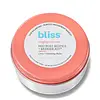What's inside
What's inside
 Key Ingredients
Key Ingredients

 Benefits
Benefits

 Concerns
Concerns

 Ingredients Side-by-side
Ingredients Side-by-side

Cetyl Ethylhexanoate
EmollientCaprylic/Capric Triglyceride
MaskingPolyethylene
AbrasiveSorbitan Sesquioleate
EmulsifyingHelianthus Annuus Seed Oil
EmollientMacadamia Ternifolia Seed Oil
EmollientCamellia Sinensis Seed Oil
HumectantWater
Skin ConditioningCentella Asiatica Extract
CleansingGlycyrrhiza Glabra Root Extract
BleachingSolanum Melongena Fruit Extract
Skin ConditioningMelaleuca Alternifolia Leaf Extract
PerfumingHouttuynia Cordata Extract
Skin ConditioningPanthenol
Skin ConditioningCeramide NP
Skin Conditioning1,2-Hexanediol
Skin ConditioningGlyceryl Stearate
EmollientButylene Glycol
HumectantSodium Hyaluronate
HumectantPantolactone
HumectantHydrolyzed Hyaluronic Acid
HumectantHydrolyzed Sodium Hyaluronate
Skin ConditioningHyaluronic Acid
HumectantHydroxypropyltrimonium Hyaluronate
Potassium Hyaluronate
Skin ConditioningPentylene Glycol
Skin ConditioningSodium Hyaluronate Crosspolymer
HumectantSodium Acetylated Hyaluronate
HumectantOryza Sativa Bran Oil
EmollientGlycerin
HumectantHydrogenated Lecithin
EmulsifyingDipropylene Glycol
HumectantPEG-20 Glyceryl Triisostearate
EmollientPEG-10 Isostearate
EmulsifyingPhenoxyethanol
PreservativeParfum
MaskingCetyl Ethylhexanoate, Caprylic/Capric Triglyceride, Polyethylene, Sorbitan Sesquioleate, Helianthus Annuus Seed Oil, Macadamia Ternifolia Seed Oil, Camellia Sinensis Seed Oil, Water, Centella Asiatica Extract, Glycyrrhiza Glabra Root Extract, Solanum Melongena Fruit Extract, Melaleuca Alternifolia Leaf Extract, Houttuynia Cordata Extract, Panthenol, Ceramide NP, 1,2-Hexanediol, Glyceryl Stearate, Butylene Glycol, Sodium Hyaluronate, Pantolactone, Hydrolyzed Hyaluronic Acid, Hydrolyzed Sodium Hyaluronate, Hyaluronic Acid, Hydroxypropyltrimonium Hyaluronate, Potassium Hyaluronate, Pentylene Glycol, Sodium Hyaluronate Crosspolymer, Sodium Acetylated Hyaluronate, Oryza Sativa Bran Oil, Glycerin, Hydrogenated Lecithin, Dipropylene Glycol, PEG-20 Glyceryl Triisostearate, PEG-10 Isostearate, Phenoxyethanol, Parfum
Cetyl Ethylhexanoate
EmollientEuphorbia Cerifera Wax
Ricinus Communis Seed Oil
MaskingSorbeth-30 Tetraoleate
EmulsifyingPolybutene
Cetearyl Alcohol
EmollientSilica
AbrasivePanthenol
Skin ConditioningTocopherol
AntioxidantMagnesium Carboxymethyl Beta-Glucan
Skin ConditioningLactococcus Ferment Lysate
Skin ConditioningSqualane
EmollientCeramide NP
Skin ConditioningCeramide AP
Skin ConditioningCeramide EOP
Skin ConditioningBeta-Carotene
Skin ConditioningBeta Vulgaris Root Extract
Skin ConditioningDaucus Carota Sativa Root Extract
Skin ConditioningGlycine Soja Oil
EmollientZinc PCA
HumectantLactic Acid
BufferingAllantoin
Skin ConditioningXanthan Gum
EmulsifyingFructooligosaccharides
HumectantPhytosphingosine
Skin ConditioningPotassium Lactate
BufferingCholesterol
EmollientPentaerythrityl Tetra-Di-T-Butyl Hydroxyhydrocinnamate
AntioxidantCarbomer
Emulsion StabilisingSodium Lauroyl Lactylate
EmulsifyingWater
Skin ConditioningPhenoxyethanol
PreservativeEthylhexylglycerin
Skin ConditioningSodium Benzoate
MaskingSodium Chloride
MaskingCetyl Ethylhexanoate, Euphorbia Cerifera Wax, Ricinus Communis Seed Oil, Sorbeth-30 Tetraoleate, Polybutene, Cetearyl Alcohol, Silica, Panthenol, Tocopherol, Magnesium Carboxymethyl Beta-Glucan, Lactococcus Ferment Lysate, Squalane, Ceramide NP, Ceramide AP, Ceramide EOP, Beta-Carotene, Beta Vulgaris Root Extract, Daucus Carota Sativa Root Extract, Glycine Soja Oil, Zinc PCA, Lactic Acid, Allantoin, Xanthan Gum, Fructooligosaccharides, Phytosphingosine, Potassium Lactate, Cholesterol, Pentaerythrityl Tetra-Di-T-Butyl Hydroxyhydrocinnamate, Carbomer, Sodium Lauroyl Lactylate, Water, Phenoxyethanol, Ethylhexylglycerin, Sodium Benzoate, Sodium Chloride
 Reviews
Reviews

Ingredients Explained
These ingredients are found in both products.
Ingredients higher up in an ingredient list are typically present in a larger amount.
Ceramide NP is a type of ceramide and formally known as ceramide 3.
Ceramides are intercellular lipids naturally found in our skin that bonds dead skin cells together to create a barrier. They are known for their ability to hold water and thus are a great ingredient for dry skin.
Ceramides are an important building block for our skin barrier. A stronger barrier helps the skin look more firm and hydrated. By bolstering the skin ceramides act as a barrier against irritating ingredients. This can help with inflammation as well.
If you would like to eat ceramides, sweet potatoes contain a small amount.
Read more about other common types of ceramides here:
Ceramide AP
Ceramide EOP
Cetyl Ethylhexanoate is an emollient ester. It comes from cetearyl alcohol and 2-ethylhexanoic acid.
Cetyl Ethylhexanoate is an emollient that adds a velvety feel to skin without being greasy or oily. Emollients help trap moisture into your skin, keeping your skin soft and hydrated.
Panthenol is a common ingredient that helps hydrate and soothe the skin. It is found naturally in our skin and hair.
There are two forms of panthenol: D and L.
D-panthenol is also known as dexpanthenol. Most cosmetics use dexpanthenol or a mixture of D and L-panthenol.
Panthenol is famous due to its ability to go deeper into the skin's layers. Using this ingredient has numerous pros (and no cons):
Like hyaluronic acid, panthenol is a humectant. Humectants are able to bind and hold large amounts of water to keep skin hydrated.
This ingredient works well for wound healing. It works by increasing tissue in the wound and helps close open wounds.
Once oxidized, panthenol converts to pantothenic acid. Panthothenic acid is found in all living cells.
This ingredient is also referred to as pro-vitamin B5.
Learn more about PanthenolPhenoxyethanol is a preservative that has germicide, antimicrobial, and aromatic properties. Studies show that phenoxyethanol can prevent microbial growth. By itself, it has a scent that is similar to that of a rose.
It's often used in formulations along with Caprylyl Glycol to preserve the shelf life of products.
Water. It's the most common cosmetic ingredient of all. You'll usually see it at the top of ingredient lists, meaning that it makes up the largest part of the product.
So why is it so popular? Water most often acts as a solvent - this means that it helps dissolve other ingredients into the formulation.
You'll also recognize water as that liquid we all need to stay alive. If you see this, drink a glass of water. Stay hydrated!
Learn more about Water